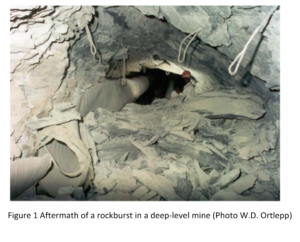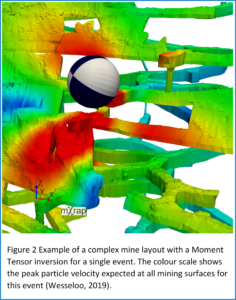When the Rock Bursts – inverting true seismic source mechanisms using Full Waveform Inversion and Machine Learning
Summary
Deep excavations cause large stress differentials leading to significant seismic hazard or “rockbursts”. These induced earthquakes are close to workers making even small magnitude events (e.g. Mw<1) hazardous. Mines began employing seismic networks some 5 decades ago to monitor induced seismicity and they use this to guide mine operations and reduce hazard. Currently, most deep-level mines have sophisticated systems for monitoring and interpreting the evolution of induced seismicity. Far less developed, is a clear understanding of where to expect large ground motions and damage from these events. These large ground motions depend on the excavations themselves, the effect of the excavation on seismic waves, and the true physical source mechanism (Linzer et al, 2020). In this project you will construct complex models of seismic wave interaction with mine excavations and apply methods from machine learning and full-waveform inversion to obtain improved inversions and predictions ultimately impacting the assessment of seismic hazard.

Recent years have seen a huge impact of wave modelling on seismic interpretation through its application within full waveform inversion (FWI) methodologies. Much of this development has been within exploration seismology with benefits to the interpretation of active seismic data. This project will develop a FWI methodology for the improved inversion of mine seismic events, including moment tensor source mechanisms and projections of peak particle velocities in the excavations, ultimately impacting the assessment of seismic hazard. Due to the importance of this work to industry, this project has a CASE partner (Australian Centre for Geomechanics).
Background
Many conventional seismic techniques make use of just the simplest attributes of recorded seismic waveforms. For example they may simply use the arrival times or amplitudes of the first arrivals. Seismic waveforms in all their complexity contain far richer information. Wave models produce full seismic waveforms and that allows comparisons with the rich full seismic dataset. Wave models have traditionally been used to enhance our understanding of seismic behaviour (e.g. Hildyard, 2007). However, advances in computing power have meant that wave models can now be used directly in the inversion of seismic data. Over the last 5-10 years, developments in this technique of full waveform inversion (FWI) have transformed the exploration seismic industry. These inversions produce higher resolution velocity models for the subsurface. FWI was initially developed for acoustic models, but this has been extended to elastic and anisotropic elastic models, and at the University of Leeds we have been extending this to full waveform inversion within explicit fracture models (Fuggi, et al, 2019).
Deep-level mining produces mining-induced seismic events and this is associated with significant seismic hazard termed “rockbursts”. Since these seismic events occur in close proximity to the mine operations and to mine workers, even small magnitude events are potentially hazardous. In mining, accurate evaluation of seismicity including locations and source mechanisms is essential. This allows an estimation of the resultant potential peak particle velocities throughout the mine particularly at excavation surfaces which is essential for correctly evaluating seismic hazard (Wesseloo, 2018) (see Figure 2).

Accurate and novel methods have been developed and optimised for mine seismology such as relative moment tensor inversions (Linzer, 2005). Wave models have been applied for many decades in the mining industry to understand rockburst mechanisms and to evaluate and improve seismic methods (Hildyard, 2007). Linzer et al (2020) investigates how the mining itself influences the earthquake source and reviews the work in this field over the last few decades. However, until now, these models have been used indirectly rather than directly in the inversion and assessment process. Recent studies in passive seismology using elastic wave models within a full waveform inversion methodology, have shown success in simultaneously improving locations and moment tensor source mechanisms (Willacy et al, 2019). This PhD project aims to drastically improve inversions of mining seismic events by implementing full waveform inversion methodologies. The project will then use the improved forward models to update projections of peak particle velocity hence improving assessments of seismic or rockburst risk. A particular challenge posed by mining are the voids and the high contrast velocity structure due to the excavation. Wave models used in the FWI need to account correctly for the excavation itself. The project will therefore use the Leeds-based code WAVE3D (Hildyard, 2005) while Mine seismic data and a tool for studying and interpreting this data (mXrap) will be provided by the Australian Centre for Geomechanics (ACG).
Aims and Objectives
The main purpose of this work is to lead to more accurate predictions in the amplitudes and distributions of ground motion in mines thereby directly impacting the assessment of seismic hazard. The aim of the project is to produce inversions of the true driving source mechanisms in mine seismic events decoupling the influence of the excavation from the “apparent” source mechanisms which are produced by conventional inversions. The objectives are to
- Gain expertise in elastic wave modelling, moment tensor inversion, machine learning, full waveform inversion, seismic hazard analysis.
- Develop forward models which accurately calculate seismic responses for complex mine layouts for given event locations and known source mechanisms.
- Use standard Moment Tensor Inversion (MTI) to invert “apparent” source mechanisms.
- Use Machine Learning (ML) to investigate whether hidden relationships can be identified between these apparent source mechanisms and the true source mechanisms
- Develop a full waveform inversion (FWI) methodology which inverts for the true driving source mechanism, decoupling the influence of the excavation.
- Assess the level to which these more accurate driving mechanisms influence predictions of the distributions and magnitudes of peak particle velocities and hence how it impacts seismic hazard assessment.
CASE partner – Australian Centre for Geomechanics (ACG)
This project has as its CASE partner, the Australian Centre for Geomechanics (ACG). The ACG is a world-renowned centre with a mandate for research training and technology transfer in mining geomechanics. The ACG is a world leader in the field of mining-induced seismicity and rockburst risk management and has developed the software mXrap used by at more than 40 seismically active mine sites in Austalia, Sweden, South Africa, USA and Canada https://mxrap.com/the-mxrap-consortium/. mXrap is a data analysis monitoring and development platform developed to enable technology transfer to mine sites. At the ACG the student will receive specialist training in mining-induced seismicity and rockburst risk management and the use of mXrap.
High Impact
Rockbursts are serious hazards in deep-level mining. Any advance in mitigating risk has a direct impact on the safety of mining personnel. It has indirect economic impact too. Academically, this work can lead to high impact papers, due to the societal importance of the field, and due to the novel applications of current cutting edge techniques such as FWI and ML.
Training
The project is led by Dr Mark Hildyard an expert in seismic and geomechanical modelling. In his group you will gain knowledge in modelling and in full waveform inversion (FWI). You will be trained in the use of the code WAVE3D and will use this in your research developments. You will also have access to considerable expertise in both full waveform inversion (FWI) and machine learning (ML) through co-supervisor Dr Sjoerd de Ridder. The project requires using cutting edge supercomputers which are available through the University of Leeds and the university will provide you training in High Performance Computing. You will have access to guidance from leading experts in industry – Dr Lindsay Linzer (SRK consulting) in mining seismology and moment tensor inversion (MTI), and Dr Johan Wesseloo (ACG) in rockbursts, risk management and seismic hazard assessment. The Australian Centre for Geomechanics (ACG) is a CASE partner and you will spend time training at the ACG and will use specialist software developed at the ACG. While based at the ACG you will receive training in theoretical aspects of mining-induced seismicity and rockburst risk management, using mXrap apps for the analysis and interpretation of mining-induced seismic catalogues, mXrap app development, and support for enhanced integration of mXrap apps with WAVE3D. Through the ACG, you will have access to mining-induced seismic catalogues from mine sites around the world (subject to the signing of a confidentiality agreement). Supervision will involve regular supervisor meetings and interaction with other researchers on related projects. You will be actively encouraged to attend and present work at conferences and to publish papers. You will also have access to a broad spectrum of training workshops put on by the Faculty from training in numerical modelling, programming, high performance computing, through to managing your degree or preparing for your viva.
Student Profile
Applications are welcome from graduates in all Geophysical Sciences, as well as in computer science, mathematics, physical sciences, and engineering. Strong scientific programming skills are important. A fundamental knowledge of seismology would be of benefit though not essential.
References
- Fuggi, A., Hildyard, M.W., Hooper, A., Clark, R.A., and Brittan, J. (2019) Genetic Full Waveform Inversion to characterise fractures, EAGE 2019.
- Hildyard, M.W., (2007). Manuel Rocha Medal recipient: Wave interaction with underground openings in fractured rock, Rock Mechanics and Rock Engineering, Vol. 40, pp 531-561. https://doi.org/10.1007/s00603-007-0158-3.
- Linzer, L.M., (2005). Manuel Rocha Medal Recipient A Relative Moment Tensor Inversion Technique Applied to Seismicity Induced by Mining, Rock Mechanics and Rock Engineering, Vol. 38(2), pp 81-104. https://doi.org/10.1007/s00603-004-0041-4.
- Linzer LM, Hildyard MW, Spottiswoode SM, Wesseloo J. (2020) Do stopes contribute to the seismic source? The Journal of The Southern African Institute of Mining and Metallurgy. 2020; Vol 120(1): pp 81-90. https://www.saimm.co.za/Journal/v120n01p81.pdf
- Wesseloo, J. (2018). The Spatial Assessment of the Current Seismic Hazard State for Hard Rock Underground Mines, Rock Mechanics and Rock Engineering, Vol. 51, pp 1839-1862. https://doi.org/10.1007/s00603-018-1430-4.
- Willacy, C., van Dedem, E., Minisini1,S., et al, (2019) Full-waveform event location and moment tensor inversion for induced seismicity, Geophysics, vol. 84, no. 2, p. ks39–ks57. https://doi.org/10.1190/geo2018-0212.1
